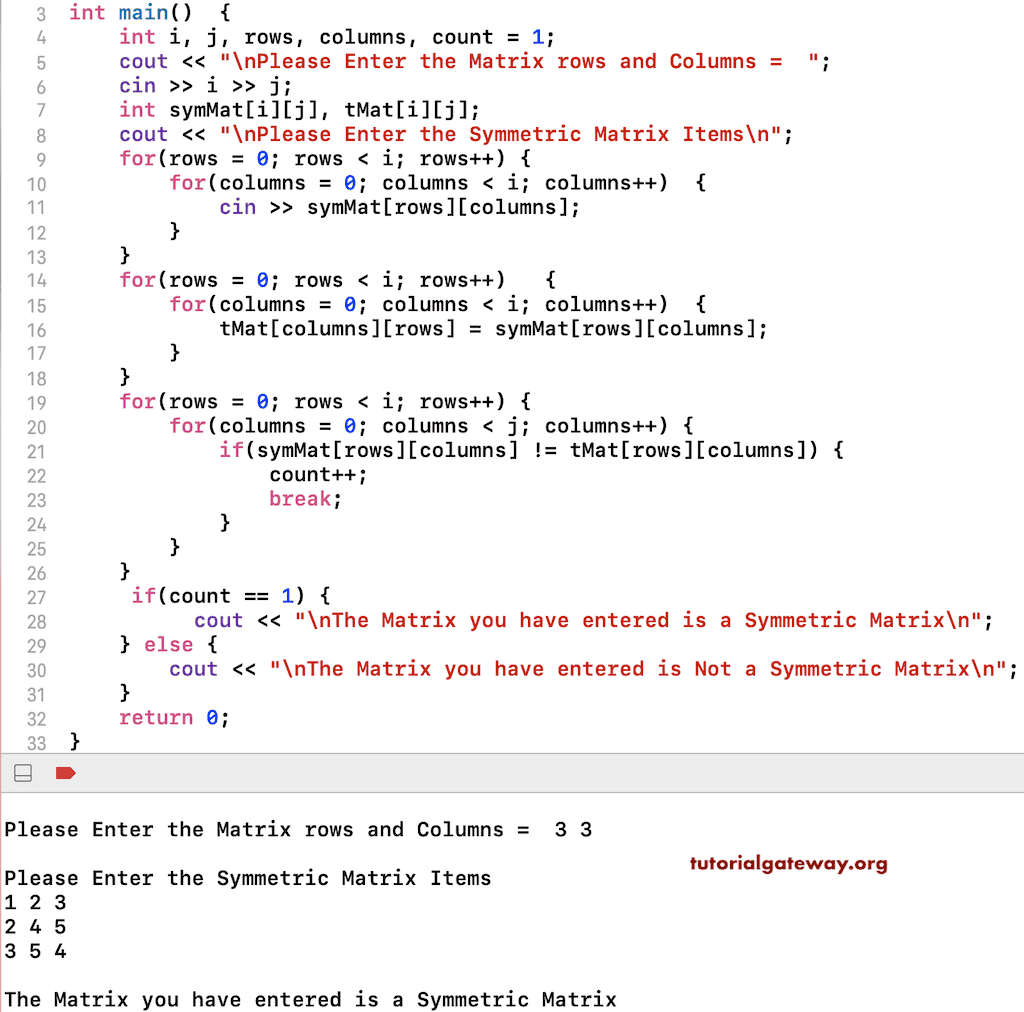编写一个 C++ 程序来检查矩阵是否为对称矩阵,并附有示例。如果原始矩阵等于其转置矩阵,则任何矩阵都可以是对称的。在此对称矩阵示例中,我们首先转置 symMat 并将其赋给 tMat。
接下来,我们检查 symMat 矩阵中的每个元素是否不等于 tMat 矩阵(if(symMat[rows][columns] != tMat[rows][columns]))。如果失败,则增加计数器值,并且 break 语句将帮助编译器退出循环。如果计数器值为 0,则表示该矩阵是对称矩阵。
#include<iostream>
using namespace std;
int main()
{
int i, j, rows, columns, count = 1;
cout << "\nPlease Enter the Matrix rows and Columns = ";
cin >> i >> j;
int symMat[i][j], tMat[i][j];
cout << "\nPlease Enter the Symmetric Matrix Items\n";
for(rows = 0; rows < i; rows++)
{
for(columns = 0; columns < i; columns++)
{
cin >> symMat[rows][columns];
}
}
for(rows = 0; rows < i; rows++)
{
for(columns = 0; columns < i; columns++)
{
tMat[columns][rows] = symMat[rows][columns];
}
}
for(rows = 0; rows < i; rows++)
{
for(columns = 0; columns < j; columns++)
{
if(symMat[rows][columns] != tMat[rows][columns])
{
count++;
break;
}
}
}
if(count == 1)
{
cout << "\nThe Matrix you have entered is a Symmetric Matrix";
}
else
{
cout << "\nThe Matrix you have entered is Not a Symmetric Matrix";
}
return 0;
}

使用 While 循环检查矩阵是否为对称矩阵的 C++ 程序
#include<iostream>
using namespace std;
int main()
{
int i, j, rows, columns, count = 1;
cout << "\nPlease Enter the Matrix rows and Columns = ";
cin >> i >> j;
int symMat[i][j], tMat[i][j];
cout << "\nPlease Enter the Symmetric Matrix Items\n";
for(rows = 0; rows < i; rows++)
{
for(columns = 0; columns < i; columns++)
{
cin >> symMat[rows][columns];
}
}
rows = 0;
while(rows < i)
{
columns = 0;
while(columns < i)
{
tMat[columns][rows] = symMat[rows][columns];
columns++;
}
rows++;
}
rows = 0;
while(rows < i)
{
columns = 0;
while(columns < i)
{
if(symMat[rows][columns] != tMat[rows][columns])
{
count++;
break;
}
columns++;
}
rows++;
}
if(count == 1)
{
cout << "\nThe Matrix you have entered is a Symmetric Matrix";
}
else
{
cout << "\nThe Matrix you have entered is Not a Symmetric Matrix";
}
return 0;
}
Please Enter the Matrix rows and Columns = 3 3
Please Enter the Symmetric Matrix Items
10 20 30
20 50 60
30 60 50
The Matrix you have entered is a Symmetric Matrix在此 C++ 示例中,我们添加了额外的 cout 语句来显示迭代的行值、symMat[rows][columns] 值、tMat[columns][rows] 值和列值。
#include<iostream>
using namespace std;
int main()
{
int i, j, rows, columns, count = 1;
cout << "\nPlease Enter the rows and Columns = ";
cin >> i >> j;
int symMat[i][j], tMat[i][j];
cout << "\nPlease Enter the Items\n";
for(rows = 0; rows < i; rows++)
{
for(columns = 0; columns < i; columns++)
{
cin >> symMat[rows][columns];
}
}
for(rows = 0; rows < i; rows++)
{
cout << "\nRow Iteration = " << rows + 1 << ", Row Number = " << rows;
for(columns = 0; columns < i; columns++)
{
cout << "\nColumn Iteration = " << columns + 1 << ", Column Number = " <<
columns << ", and Row Number = " << rows;
tMat[columns][rows] = symMat[rows][columns];
cout<<"\nValue of (symMat[" << rows << "][" << columns << "] = " << symMat[rows][columns] << ". So, tMat["
<< columns << "][" << rows << "]) = " << tMat[columns][rows];
}
}
cout <<"\n";
for(rows = 0; rows < i; rows++)
{
cout << "\nRow Iteration = " << rows + 1 << ", Row Number = " << rows;
for(columns = 0; columns < j; columns++)
{
cout << "\nColumn Iteration = " << columns + 1 << ", Column Number = " <<
columns << ", and Row Number = " << rows;
cout<<"\nResult of (symMat[" << rows << "][" << columns << "] != tMat["
<< rows << "][" << columns << "]) = " << (symMat[rows][columns] != tMat[rows][columns]);
if(symMat[rows][columns] != tMat[rows][columns])
{
count++;
break;
}
}
}
if(count == 1)
{
cout << "\nThe Matrix you have entered is a Symmetric";
}
else
{
cout << "\nThe Matrix you have entered is Not a Symmetric";
}
return 0;
}
Please Enter the rows and Columns = 2 2
Please Enter the Items
10 20
20 10
Row Iteration = 1, Row Number = 0
Column Iteration = 1, Column Number = 0, and Row Number = 0
Value of (symMat[0][0] = 10. So, tMat[0][0]) = 10
Column Iteration = 2, Column Number = 1, and Row Number = 0
Value of (symMat[0][1] = 20. So, tMat[1][0]) = 20
Row Iteration = 2, Row Number = 1
Column Iteration = 1, Column Number = 0, and Row Number = 1
Value of (symMat[1][0] = 20. So, tMat[0][1]) = 20
Column Iteration = 2, Column Number = 1, and Row Number = 1
Value of (symMat[1][1] = 10. So, tMat[1][1]) = 10
Row Iteration = 1, Row Number = 0
Column Iteration = 1, Column Number = 0, and Row Number = 0
Result of (symMat[0][0] != tMat[0][0]) = 0
Column Iteration = 2, Column Number = 1, and Row Number = 0
Result of (symMat[0][1] != tMat[0][1]) = 0
Row Iteration = 2, Row Number = 1
Column Iteration = 1, Column Number = 0, and Row Number = 1
Result of (symMat[1][0] != tMat[1][0]) = 0
Column Iteration = 2, Column Number = 1, and Row Number = 1
Result of (symMat[1][1] != tMat[1][1]) = 0
The Matrix you have entered is a Symmetric